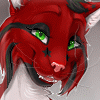
I've been working on this painting for a client over about five months, and it's finally complete. The client requested my interpretation of Horus, with some requested additions. Here he is shown with his right eye as the sun, with stars flowing from his left moon-eye.
Acrylic on board, 11X14 inches
Acrylic on board, 11X14 inches
Category Artwork (Traditional) / Fantasy
Species Falcon
Size 1000 x 790px
File Size 846.3 kB
Listed in Folders
Aw thanks! :3 I did a bunch of research to make sure I got things right (like the double crown and the Was scepter). There were a few add-ons that aren't traditionally seen on Horus, such as wings on his human form, but since I was going for my own interpretation (and the wishes of the client), I figured additions were fine as long as they fit overall.
Everything looks fine to me. Even the human build (with great anatomy) is consistent with the way nearly every pharaoh* was portrayed. They always had those broad shoulders even if in real life he was skinny with a twisted foot like Siptah and Tutankhamun. I have to say most artists wouldn't bother to paint the curl of the red crown or even know what it was.
* The obvious exception being Akhenaten who was always portrayed weirdly.
* The obvious exception being Akhenaten who was always portrayed weirdly.
The art in that period could be both very exaggerated and strangely naturalistic and anatomical at the same time. Some of the most spectacular examples are the work from the workshop of Thutmose (the sculptor) at Amarna. The head shapes are very distorted but you can see the individual bones of the skull portrayed accurately. It's no wonder people think they're alien hybrids. There's a beautiful book from the Met that you can download as a PDF showcasing some of the best finds from the workshop.
http://www.metmuseum.org/research/m....._Ancient_Egypt
That's probably the period when Egyptian art came closest to what you'd call art today. Most art in ancient Egypt served what you'd call a' magical or religious purposes most of the time. There are also surviving sketches and cartoons but the stuff that got paid for mainly had some definite magical purpose like those vignettes.
http://www.metmuseum.org/research/m....._Ancient_Egypt
That's probably the period when Egyptian art came closest to what you'd call art today. Most art in ancient Egypt served what you'd call a' magical or religious purposes most of the time. There are also surviving sketches and cartoons but the stuff that got paid for mainly had some definite magical purpose like those vignettes.
Also, I should probably mention that 'composite deities' are often portrayed as humans with wings and multiple heads and other parts. You'll see them in the vignettes in some versions of the 'Book of the Dead' and some magical papyri. Anyone people who don't read Egyptology publications wouldn't be aware of that. Most people would only have seen Isis (Auset) and maybe Nepethys with wings and those usually look like she's wearing a costume except when she's portrayed a kite.

 FA+
FA+















Comments